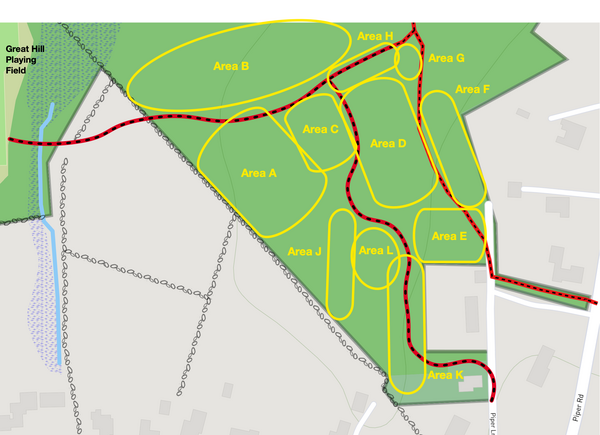Gaebel/Magoun Lands

In the early 2000s, the town managed to purchase two additions to the Great Hill Conservation Area, the Gaebel (2008) and Magoun (2020) properties. These properties had been neglected for decades, and have some serious infestations of invasive species.
Issues w. the Magoun Land
There was serious community involvement resistance to the Magoun property development (which would have placed a 20+ unit development in six acres inside the current Great Hill boundaries). In the end, it was the discovery that there were worrying levels of Arsenic in the ground in several location, due to spills when it was being used as an orchard (prior to 1960). In the words of one consultant, he considered it one of the worst examples of Arsenic contamination on the East Coast.
This should be taken into account when working these lands. These are mainly invasive areas A, B, C, D, J, and L. Disturbance of the soil in these areas should be minimized, especially when dry and likely to generate dust.
Area A
This is the area with the least invasive plant species infestation. It is mainly infested with Glossy Buckthorn, with some Asian Bittersweet and Winged Euonymus.
It has been swept in 2022 and 2023.
Area B
This area has infestations of Glossy Buckthorn, and some Winged Euonymus, Asian Bittersweet, and Multiflora Rose.
The effort here has been concentrated around removing the Glossy Buckthorn and MF Rose from the wetlands to the east, with yearly sweeps between 2020 and 2023. The Glossy Buckthorn infestations uphill have been harassed, but not eliminated.
Area C
This area has had a moderate infestation of Glossy Buckthorn, Winged Euonymus, and Asian Bittersweet.
It was first cleared in 2020, and has seen sporadic re-clearing since then.
Area D
This area has had a serious infestation of Glossy Buckthorn, Winged Euonymus, and Asian Bittersweet, with some Bush Honeysuckle and Autumn Olive thrown in for balance.
The Asian Bittersweet along the edges of the trail were first fiattacked in 2015 or so.
In 2019, a trail was first cut across this infestation, followed by a second and third trails in the early 2020s. In early 2024, cutback of serious regrowth continues.
This area also has several small infestations of Garlic Mustard.
Area E
This area is looking OK as long as you consider Vinca (Vinca minor) a native plant. There is an infestation of that competing with Pachysandra. The good news is that since 2020 the Winged Euonymus and Glossy Buckthorn growing in this area have been diminished.
Area F
This area shares Area E's problems with Winged Euonymus and Glossy Buckthorn.
It has been swept yearly from 2018 through 2023, and is starting to look much better.
Area G
This is Glossy Buckthorn corner (of course w. Asian Bittersweet thrown in)!
It has been cut back every year since 2020.
Area H
This is the area along the path leading toward the Playing Field which doesn't have a large number of invasives (less every year), but has a world class Poison Ivy infestation.
Area J
This area was bulldozed by the developer, removing the upper canopy, before the town purchased the land. As a result, it is a nightmare of Vinca Minor and Asian Bittersweet, with some Glossy Buckthorn thrown in.
Area K
This area is infested with Winged Euonymus and Norway Maple.
Area L
This is a wetland area. It is a depression without drainage, which can collect a fair amount of water in the spring. It is also a high tick infestation area.